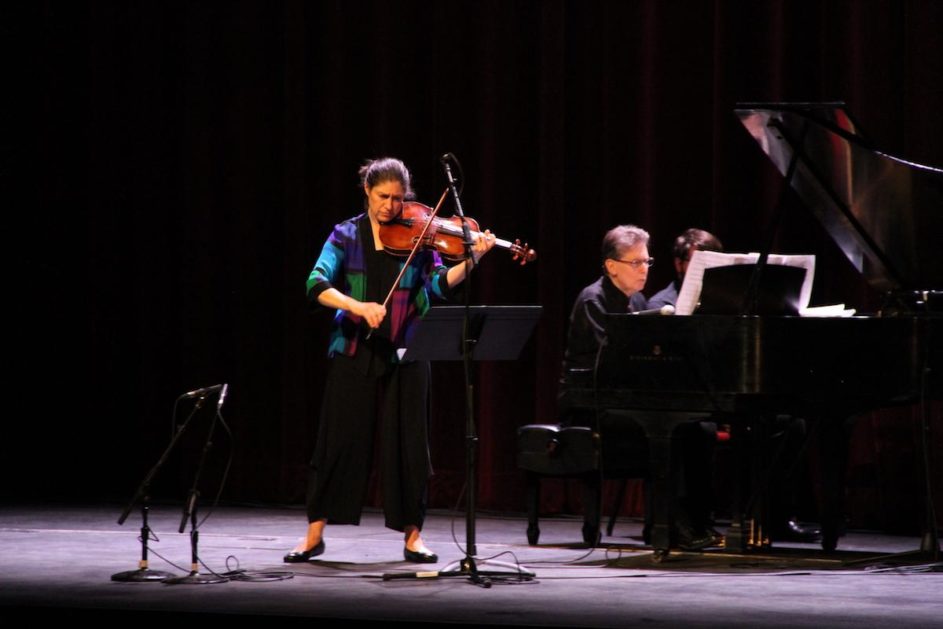Trying to define just what kind of festival Big Ears is, much less defining the categories of music played during the festival, means coming to terms with the concept of edgeless genres. Giving up trying to find the point at which classical music becomes something else. The same for jazz, folk, bluegrass, experimental rock. Or whatever other music shows up at Big Ears.

Legendary jazz guitarist Ralph Towner
It’s why coming to Big Ears, which took place March 21-24 at venues around downtown, requires an open mind and a willingness to have it stretched beyond one’s normal boundaries.
Certainly many of the musicians are somewhere near the middle of the type of music they are known for performing.
Virtuoso violist Kim Kashkashian stayed well within her classical genre with both her solo performance of Bach preludes and partitas and other music at St. John’s Cathedral Friday evening, as well as her performance with pianist Robert Levin Saturday afternoon at the Tennessee Theatre.
It’s thanks to ECM Records’ 50th anniversary celebration Kashkashian and Levin were even here. They play together a lot but mostly on chamber music concerts. Saturday afternoon they played short little songs by Argentinian composers Carlos Guastavino and Alberto Ginastera.
But they also played American composer John Harbison’s “Sonata for Viola and Piano,” completed just last summer. Harbison is 80 now and, judging from the titles he gave the sonata’s six movements, is thinking about the end of his composing career – and maybe the end of his life. The first movement is titled “Resolution,” the second one “Passage,” then “Night Place,” “Certainties, Uncertainties,” “Questions” and “Answers.” As the sonata progresses, each movement is shorter than the one before it.
Then they played Johannes Brahms’ “Sonata in E Flat Major,” Op. 120, #2. Written late in Brahms’ life, it’s a kind of recollection of past events.

Meredith Monk, far right, with her vocal ensemble at the Bijou Theatre
But contrast this music with the performance of Meredith Monk and her Vocal Ensemble Friday evening at the Bijou Theatre with a capacity crowd in attendance. Where Kashkashian is down the middle of classical music, Monk continually explores the outer fringes. She has created musical and language vocabulary of her own. It isn’t the kind of abstract sounds of someone like Joan La Barbara whose voice produces sounds somewhere between machine, animal and human voice.
Monk makes some of those sounds, too. But she also has a whole glossary of her own syllables that she gives meaning to through her performance, by which I mean a kind of theater mixed with abstract dance movement and vocal noises, all of which are designed to convey a narrative.
I’m sure the same kinds of things are happening in the other music genres at Big Ears. It’s just impossible to explore all of them. But there are also artists who are sort of in their own bracket by themselves.

Dutch pianist Joep Beving
One is the Dutch pianist-composer Joep Beving, who played at the Knoxville Museum of Art early Friday afternoon. Music found Beving when his grandmother gave him an upright piano. He gradually found on it the kinds of sounds he heard in his head and put together a recording of “mood music,” for lack of better description, for the enjoyment of his family.
Just for fun, he posted it on the internet site Spotify. It got millions of hits. So he recorded another album and put it up. Collectively, his recordings now have more than 85 million listenings. His playing at KMA had very thick and dense textures. It can also be gossamer thin and delicate. All played on an upright piano, of course. He’s now released his third album and landed himself a place at Big Ears and other concert locations around the world.

Icelandic singer and pianist Anna Valtysdóttir at St. John’s Cathedral
In contrast to the almost structural sound of Beving was Icelandic pianist and singer Kristin Anna Valtysdóttir, who played at St. John’s Cathedral Saturday afternoon. Her playing is much lighter, and her high, thin voice has a shakiness to it that gives her music a sense of vulnerability.

Jazz bassist Larry Grenadier at St. John’s Cathedral
Also performing at St. John’s early Friday afternoon were jazz bassist Larry Grenadier and, later in the day, the legendary jazz guitarist Ralph Towner. Both men’s music finds different places in the mind and soul. But they are just as satisfying.

